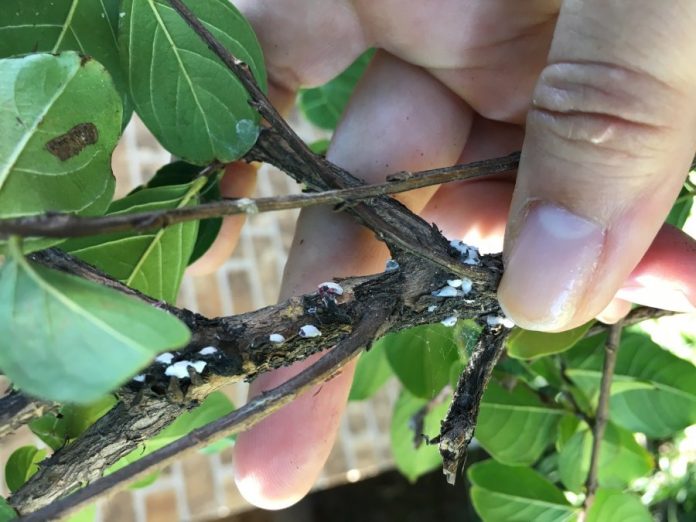
by Janet Laminack, Denton County Extension Agent-Horticulture
Crape myrtles are a favorite shrub and tree for our area. They have gorgeous blooms in the heat of summer and many varieties have lovely exfoliating (peeling) bark. Yes, the bark shedding off like that is considered an ornamental feature.
Crape myrtles have also been relatively problem free until recently, with the invasion of the crape myrtle bark scale. This insect is a new arrival to the U.S. from Asia. The scale insect looks like a white dot on the branches and trunks of the crape myrtle. If you crush the larger female scales, they “bleed” a pink color.
Thus far, the damage caused by this scale has not been too extensive. Many people may not have even noticed the pest on their trees. The biggest problem with the scale is the effect it has on the aesthetics of the crape myrtle. It does appear to reduce flowering. Then there’s the problem with the sooty mold. Scale secretes a sugary substance called honeydew, which is a host for a fungus known as sooty mold. Honeydew is also attractive to ants so you may see a lot of ant activity on your tree.
Sooty mold is not damaging the tree, but it can be unattractive. It is a dark velvety coating that can be found on the branches of trees with scale. In my opinion, some crape myrtles with sooty mold are even more striking and attractive because of the added contrast of the black bark coupled with the exfoliation. But most people find it unsightly and would like to get rid of it. Sooty mold can be removed by cleaning the tree with a soft brush and some dish washing liquid; and sometimes rain alone can get rid of it.
How do you control the insect? Washing the tree, when feasible, can help remove the insects and their eggs. You can also use a soil drench systemic insecticide with active ingredient of imidaloprid or dinotefuran. These should be applied between May and July. Another option is to use a dormant horticultural oil spray. This should be used after leaf drop in the fall and before bud break in the spring. Texas A&M AgriLife Extension is currently researching this pest further, so hopefully I will have some better news for you soon.
Don’t forget about these upcoming opportunities, “Design Your Yard with Earth-Kind Landscaping” class from October 19-21. Space is limited and registration is required, cost is $50/per person or $75/couple. More information about this class is found on our webpage (dcmga.com) or by calling 940.349.2883.
Come find out more about becoming a Master Gardener on October 11, from 10 a.m. to noon at the AgriLife Extension office in the Joseph A. Carroll building, 401 W. Hickory St, Denton. This informal event will feature a social, refreshments and information about becoming a Master Gardener. The deadline for applications to apply for the spring class is October 14. Classes begin January 31 and run through May 2, every Tuesday from 9 a.m. until 4 p.m. The cost is $240. We will seek to provide reasonable accommodation for all persons with disabilities for our programs, please notify us in advance.
And as always, our help desk is open to answer your questions at 940.349.2892 or email master.gardener@dentoncounty.com.

















